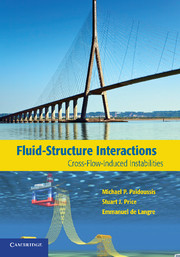Book contents
- Frontmatter
- Contents
- Preface
- 1 Introduction
- 2 Prisms in Cross-Flow – Galloping
- 3 Vortex-Induced Vibrations
- 4 Wake-Induced Instabilities of Pairs and Small Groups of Cylinders
- 5 Fluidelastic Instabilities in Cylinder Arrays
- 6 Ovalling Instabilities of Shells in Cross-Flow
- 7 Rain-and-Wind-Induced Vibrations
- Epilogue
- Appendix A The Multiple Scales Method
- Appendix B Measurement of Modal Damping for the Shells Used in Ovalling Experiments
- References
- Index
Preface
Published online by Cambridge University Press: 04 February 2011
- Frontmatter
- Contents
- Preface
- 1 Introduction
- 2 Prisms in Cross-Flow – Galloping
- 3 Vortex-Induced Vibrations
- 4 Wake-Induced Instabilities of Pairs and Small Groups of Cylinders
- 5 Fluidelastic Instabilities in Cylinder Arrays
- 6 Ovalling Instabilities of Shells in Cross-Flow
- 7 Rain-and-Wind-Induced Vibrations
- Epilogue
- Appendix A The Multiple Scales Method
- Appendix B Measurement of Modal Damping for the Shells Used in Ovalling Experiments
- References
- Index
Summary
Structures in contact with fluid flow, whether natural (e.g. wind and ocean currents) or man-made, are inevitably subject to flow-induced forces and flow-induced vibration: from plant leaves to traffic signs, to more substantial structures, such as bridge decks and heat-exchanger tubes. These vibrations may be of small or large amplitude, and they may be inconsequential, or of mild or even grave concern.
Consider overhead transmission lines, bridges, tall buildings, and chimneys subjected to wind, offshore risers and umbilicals in ocean currents, cylinders and cylindrical tube arrays in power-generating and chemical plants, for example. Such structures vibrate to some extent at any flow velocity, e.g. due to turbulence or vortex shedding. If the vibrations are of small amplitude, they may lead to fatigue or fretting wear in the long term. However, under certain circumstances, the vibration amplitude is large, and damage may occur in the short term, in hours or weeks. Moreover, the vibration may be self-excited. Typically, but not universally, such vibration is associated with a threshold of flow velocity: on one side of the threshold, oscillations due to some perturbation imparted to the system die out; on the other side, oscillations grow. More generally, we may define self-excited vibration simply as one that grows exponentially with time until it settles down to a limit-cycle motion. Clearly, such phenomena, more specifically the conditions under which they arise, are of great importance to designers and operators of the systems concerned, because of the great potential to cause damage in the short term. Such flow-induced instabilities are the subject of this book.
- Type
- Chapter
- Information
- Fluid-Structure InteractionsCross-Flow-Induced Instabilities, pp. ix - xPublisher: Cambridge University PressPrint publication year: 2010



